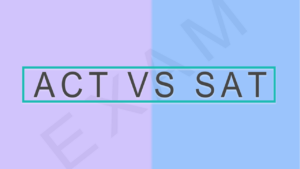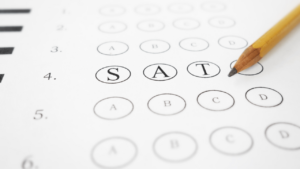The Scholastic Assessment Test (SAT) is a standardised test that high school students take in order to be admitted to undergraduate courses at US schools. Other nations that accept SAT scores include the United Kingdom, Australia, Canada, Singapore, Germany, and Malaysia. It is not, however, required. The SAT is a three-hour, pen-and-paper-based multiple-choice question test that is divided into three sections: reading, writing, language, and math. The SAT comprises a total of 154 questions, with 52 questions in the reading part, 44 in the SAT reading and writing section, and 58 in the SAT math section. The majority of students believe the SAT reading test to be the most difficult of all the sections since it contains fictional passages that can be difficult to understand due to vocabulary and question types. To do well in the reading section, you must have great comprehension and analytical skills.
Leap Advantage Virtual Spot Offer Event on May 10th 2024

Last call to secure your spot for Masters in STEM Program in the US for Fall ’24 exclusively for graduates and above.
Leap Advantage Virtual Spot Offer Event on May 10th 2024
Last call to secure your spot for Masters in STEM Program in the US for Fall ’24 exclusively for graduates and above.

Reading Test SAT Detailed Structure
In the SAT, the reading section is quite important. It tests a student’s comprehension skills to judge if they have the literary skills needed to understand what is taught at the college level. The SAT has five 500-750 word SAT reading passages, each of which is followed by a set of 10-11 multiple-choice questions. Students have 65 minutes to read all five passages and respond to the text-related questions. The first SAT reading passage is usually taken from a book or magazine and is a work of fiction. The following two paragraphs are about US history or the US constitution. The fourth paragraph could be about science, psychology, economics, or politics. The last two paragraphs contain material from earth sciences, biology, and chemistry.
Types of Questions in SAT Reading
All of the questions on the SAT Reading Test fall into one of the below-mentioned categories:
Context Clues
The questions in this category will ask you to determine which definition of a word or phrase is being utilised, or how an author’s word choice influences the overall meaning, style, or tone of a piece. These are the most particular types of queries, and they usually refer to a specific part of the text.
Small Scope
These questions will ask you to locate the part in a passage(s) that best supports the answer to a previously asked question or serves as the foundation for a plausible conclusion. These types of questions focus on what the passage says, either directly or indirectly, and the solution may always be found explicitly in the text, though the placement will be less obvious than in context clue questions.
Large-Scope Questions
These questions usually need you to think about a bigger section of the passage or the passage as a whole. You can be asked to figure out how authors back their statements with evidence or how they transmit meaning across the piece. In general, you will need to think about the text as a whole to answer these questions.
Dual Passage Questions
These questions require you to compare, contrast, or make conclusions from numerous texts or passages that include visual information. You will have to create connections, figure out how an informational graphic relates to the material, and compare how one concept is presented in two different ways.
SAT Reading Tips
Here are a few essential tips for aspirants to improve their reading comprehension skills and score well in the reading section:
Know What to Anticipate
When attempting the SAT, you will have 65 minutes to read five passages and answer 52 questions (from literature, history, social science, and natural sciences). The questions will require you to do everything from deciphering the meaning of words in context to analysing why an author included a certain detail, determining the primary theme of a piece, comparing two passages, and even pinpointing information on a graph.
Do Not Read the Passage for Long Periods of Time
The SAT Reading Test lasts 65 minutes and consists of five passages with questions. This means you will need to spend an average of 13 minutes per section. An SAT passage should take you roughly 5 minutes to read through. You will most likely waste time on the questions if you spend more than 5 minutes reading. If you read for less than 5 minutes, you risk missing critical information. After you have read the passage once to understand the main idea, proceed to the questions. You may not have the time to read every word of the passage. So, switch back and forth between the passage and the questions, focusing solely on the information you need rather than getting bogged down in the weeds.
Make Your Own Selections
The reading questions are provided chronologically rather than in order of difficulty. Do not be afraid to skip a difficult question, and do not be concerned if you can not answer all of them. You will find American and World Literature, History and Social Studies, and Science passages on the SAT. You don’t necessarily have to attempt the passages in the order they are presented. Start with the passage you are most comfortable with. The questions in each passage will vary in complexity. If you are having trouble with a paragraph, consider coming up with some quick, simple answers to the questions. The easier questions may test vocab words or line references that you can discover quickly in the passage. After you have answered these, you will have a better comprehension of the text and will be able to tackle the more difficult questions with less stress.
Do Not Go for Personal Viewpoints
In an English lesson, you are frequently asked to express your own opinion, which must be backed by the text. Remember that in the SAT, this is not the case. When you see the words infer, inference, indicate or suggest in a question, be cautious. Even if the solution is not explicitly stated in the text, there will be enough evidence to back up the correct answer.
If you are Zoning Out, Change your Posture & Try Again
On test day, even the highest scorers may lose focus at times, but this is no cause for alarm. Change your posture. Try slouching a little or leaning to one side while you read a piece if you have been reading it with an upright posture. Sit up straight if you have been slouching. These slight modifications can help you refocus on the SAT subject tests and finish reading or answering the question.
Even if you Are Going to Skip a Question for Later, Make A Guess
On the SAT, there is no penalty for wrong answers, so be sure you answer all of them. If you need to skip a question, mark it with a star in your exam booklet and make a quick guess on your answer grid in case you do not have time to return to it later. You do not want to be in a hurry to answer questions you have skipped as the clock ticks down.
Take One of the Dual Passages at a Time
A set of dual passages—two shorter writings on one topic—will be one of your science or history/social studies readings. Answer questions concerning the first passage should come first, followed by questions about the second passage, and finally, answer questions about both passages. This will save you time and ensure that you do not mix the two sections when examining the answer options.
Questions About the Core Idea Should be Saved for Last
The first question for many SAT Reading passages will be a broad question regarding the paragraph’s principal idea or aim, the narrative point of view, or a shift that occurs in the passage. It is best to answer the questions, focusing on the smaller sections first. After you have completed most of the other questions, you will have a better understanding of the text’s overarching topics.
Conclusion
One of the most difficult and challenging sections is the SAT reading section. Even if the applicants comprehend the passage, reading exam questions can be difficult to understand at times. As a result, it is critical for students to attempt SAT practice tests as many times as possible in order to grasp the types of questions and correctly answer them. It is not necessary to have a prior understanding of the passage’s subject or content. For more details, head on to LeapScholar.
Frequently Asked Questions:
When should I take the SAT International test?
Candidates should take the SAT International when they have successfully completed their high school and have prepared for the SAT test. Generally, candidates are recommended to take the SAT test twice as they get the benefit of super scoring. Super scoring means that if a student takes the test twice, the college will use the highest score of subjects from both the first and second attempts.
When should I start preparing for the SAT International test?
Most students prefer to start their preparation a few months earlier if they are taking the SAT International test for the first time. If you are planning to take coaching for the SAT test or read special books, the best time to start SAT prep is at least three months in advance of the test so that you have enough time.
Some students also like to start the preparation for the SAT International test before starting high school. This gives them an ample amount of time to prepare for the whole syllabus.
How should I prepare for the SAT test?
The right approach to prepare for the SAT test depends on how much time you have for preparation. For example, if you have just started high school, you can prepare on your own. You can also find SAT syllabus, but once you get closer to the SAT test, you should use books, tutoring and courses to reach your goal.
Other than that, it is also good to give proper time to subjects you feel are difficult. For instance, if your maths section is weak, make sure you allot extra hours and create a specific timeline for clearing your doubts and practice. You can also take coaching to prepare for the test.
Can I reschedule my SAT International test dates?
Yes, the CollegeBoard allows candidates to reschedule their test dates. Here is the best way of rescheduling:
Log into your student account on the College Board’s official website.
You will see your registered test under the “My SAT” section.
Click on “Change Registration” and scroll to the bottom of the next page.
Click on “Change my test date,” and you will see a number of options for SAT International Dates.
Select your SAT test centre and re-confirm that your personal details are correct.
You will also have to pay the reschedule fee.







